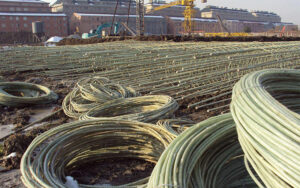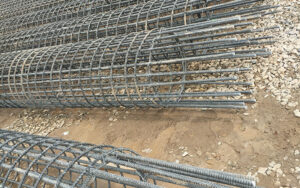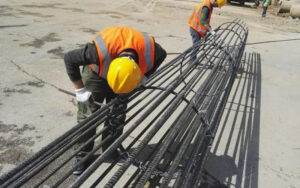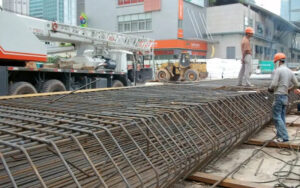Fiberglass rebar, also known as GFRP rebar, is a new type of composite material. Many customers know this product for the first time, and they don’t know the difference between it and steel rebar. Why use fiberglass rebar? Next, we will introduce the advantages and disadvantages of fiberglass rebar and steel rebar. After comparison, see if glass fiberglass rebar can replace steel rebar?
- Fiberglass rebar 2
- Fiberglass Reinforced Cage Construction
What material is fiberglass
As a new high-performance structural material, fiberglass reinforcement is widely used in subway tunnels (shields), highways, bridges, airports, docks, stations, water conservancy projects, underground engineering and other fields. Corrosive environments such as electrolyzers, manhole covers, and coastal defense projects. Fiberglass bars can solve many problems in engineering, make up for the shortcomings of traditional steel, and bring new development opportunities to civil and construction engineering.
Advantages and disadvantages of ordinary rebar and fiberglass rebar
- High bearing capacity, strong tensile capacity, the strength of the rod body is twice that of the threaded steel bar of the same diameter, but the weight is only 1/4 of the steel bar;
- The elastic modulus is stable, about 1/3~2/5 of the steel bar;
- Electrical and thermal insulation, the thermal expansion coefficient is closer to cement than steel;
- Good corrosion resistance, suitable for use in wet or other corrosive environments such as water conservancy, bridges, docks and tunnels;
- The shear strength is low, and the shear strength of ordinary glass fiber bars is only 50~60MPa, which has excellent cutting performance. It is basically similar to steel bars in performance, has good adhesion to concrete, and at the same time has high tensile strength and low shear strength, which can be easily cut directly by the composite shield machine without Causes abnormal tool damage.
- Fiberglass rebar construction site
- FRP rebar subway diaphragm wall case
The difference between fiberglass rebar and steel rebar
- In terms of the construction period, compared with ordinary steel bars, fiberglass reinforcement is customized by manufacturers. Since it cannot be processed on-site, it is necessary to precisely control the size. Once the material is cut incorrectly, the construction period will be delayed. Its shape is directly customized, which reduces the processing steps of ordinary steel bars, and the lap joint method of binding replaces the welding process, which saves the production time of the reinforcement cage.
- In terms of construction difficulty, the flexural and shear bearing capacity of fiberglass reinforcement is much different from that of ordinary steel bars, and the weight is lighter, so the stability of the reinforcement cage is not as good as that of ordinary steel cages during the lifting, lowering and pouring of the cage, and it is easy to appear scattered. Special conditions such as cages, cages, floating, etc., need special attention in the production and hoisting of tendon cages.
- In terms of construction safety, compared with the currently widely used construction method of partially or completely breaking the reinforced cage diaphragm wall at the shield ends, the fiberglass reinforced cage diaphragm wall can be directly penetrated by the shield machine, avoiding the easy mud gushing, Dangerous conditions such as water gushing and sand gushing save the cost of breaking the diaphragm wall and reduce pollution such as dust and noise.
- In terms of economy, compared with ordinary steel bars, glass fiber bars are lighter, and the change of direction reduces the cost of making and installing the bar cage. At the same time, due to the larger glass fiber bar cage, the width of the diaphragm wall is reduced, and the interface labor of the diaphragm wall is saved. The number of steel beams or locking tubes saves costs.
Characteristics of fiberglass rebar
- High tensile strength: The tensile strength of glass fiber bars is better than that of ordinary steel bars, which is 20% higher than that of steel bars of the same specification, and has good fatigue resistance.
- Light weight: The quality of glass fiber bars is only 1/4 of the same volume of steel bars, and the density is between 1.5 and 1.9 (g/cm3).
- Strong corrosion resistance: The corrosion resistance of chemicals such as acid and alkali can resist the corrosion of chloride ions and low pH value solutions, especially the corrosion resistance of carbon compounds and chlorine compounds.
- Strong material bonding: The thermal expansion coefficient of glass fiber reinforcement is closer to that of cement than steel, because the bonding force of glass fiber reinforcement and concrete is stronger.
- Strong designability: The elastic modulus of the glass fiber rib is stable, the size is stable under thermal stress, the bending and other shapes can be thermoformed arbitrarily, and the safety performance is good. Collision does not produce sparks.
- Strong magnetic wave permeability: glass fiber reinforced is a kind of non-magnetic material, and it does not need to be demagnetized in non-magnetic or electromagnetic concrete components.
- Convenience in construction: fiberglass bars can be produced in standard and non-standard parts of various sections and lengths according to user requirements, and non-metal tensioning belts can be used for on-site binding, which is easy to operate. When you wholesale fiberglass, you must choose a regular fiberglass manufacturers to buy.
Fiberglass rebar is expensive or rebar is expensive?
φ12 fiberglass rebar is more than 10,000 per ton, 5,000 meters; rebar is more than 4,000 per ton, 1100 meters; if the price is calculated from meters, the glass fiber rebar is lower than the rebar; if the price is calculated from the ton, the rebar is higher than the glass fiber rebar ; According to market price information, glass fiber reinforced steel is slightly more expensive than steel reinforced, and at the same time, it also reduces the cost of breaking reinforced concrete by about 30,000 yuan when using ordinary diaphragm walls to enter and exit the shield tunnel. In general, the cost of using glass fiber steel bars is reduced to a certain extent, and the use of glass fiber diaphragm walls reduces the safety risks such as mud, sand, and water gushing during the construction of reinforced concrete diaphragm walls, and shortens the construction period by 7-10. sky.
The above is an introduction to the advantages and disadvantages of fiberglass rebar and steel rebar. As a new high-performance structural material, glass fiber rebar is widely used in subway tunnels (shield tunnels), highways, bridges, airports, docks, stations, water conservancy projects, Underground engineering and other fields, it can adapt to corrosive environments such as sewage treatment plants, chemical plants, electrolyzers, manhole covers, and coastal defense projects. Fiberglass rebar can solve many problems in engineering, make up for the shortcomings of traditional steel, and bring new development opportunities to civil and construction engineering.
































